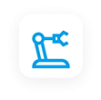Could you imagine a modern production facility or storehouse without a crane?
Whether manufacturing, logistics, or construction, nearly all industrial sectors need overhead cranes. They provide an efficient way to lift, carry, and transport large, heavy cargo and equipment that wouldn’t be possible otherwise.
However, huge machines come with huge risks. If you don’t operate and maintain them carefully, they can cause serious mishaps, injuries, and even casualties. According to OSHA, US Department of Labor, there were 156 injuries and 130 fatalities between 2000 and 2023 due to overhead crane accidents, leading to an economic impact of over $500 million.
That’s why you must ensure safe overhead crane operations to protect workers, prevent disasters, and avoid heavy financial losses plus reputational damage.
Besides adhering to OSHA regulations, the most assured way to do this is to equip your overhead cranes with cutting-edge crane collision avoidance sensors.
Understanding the Sensor Technology For Crane Collision Avoidance
An automated crane collision avoidance system, with sensors as its fundamental components, helps you minimize the possibility of accidents when operational. Sensors use various technologies, including lasers, infrared, ultrasonic, and LiDARs with AI capabilities.
These sensors seamlessly connect to the crane’s control system, performing automated distance measurements and detecting potential collisions in real time. They enable almost instantaneous crane control to limit or stop their movement when there’s a possibility of crane-crane, crane-object, or crane-human collision, enabling safe and efficient operation.
The following sensors are particularly beneficial in automating crane collision avoidance:
Collision Avoidance Sensors
These sensors emit and catch infrared rays to and from a reflector, detecting obstacles in a crane’s path. If there is a collision potential, the system triggers an alarm through visual signals, audible sirens, or remote screen notifications, allowing an automated system or the operator to stop or slow down the crane instantly.
For instance, Hokuyo’s KAD-300 sensor, usually attached to a crane bridge with a reflector on the other end, can detect objects up to 100 feet in the runway area and stop or slow down crane movement. Similarly, Hokuyo’s RSC-30LN is another sensor specializing in higher to lower bay crane operations. It has a wide scan angle and detection span, reducing collision risks between overhead cranes and fixed objects.
LiDARs
A LiDAR (Light Detection and Ranging) is another obstacle-detection sensor. It uses ultrasound, lasers, or LEDs to measure distances between objects and create a 2D/3D map of the surrounding area. With real-time mapping, the crane's control system can identify potential collisions with obstacles or other cranes, enabling it to restrain the crane’s movement or shut it down completely to prevent accidents.
Hokuyo offers several series of LiDAR sensors, such as PBS, UST, UTM, and more. Each has different capabilities and applications ranging from real-time area monitoring to presence detection and spatial recognition.
Safety Laser Scanners
These devices perform 2D scans of their environments using infrared laser emissions, creating a laser field within the surrounding area. The sensor then identifies anyone or anything that enters this field and crosses the beam, sending an alert to the operator or the control system.
For instance, Hokuyo’s safety laser scanners, among the smallest devices on the market, allow you to prevent dangerous situations from as long as 30 meters with a 270° field of view.
Why Collision Avoidance Sensors Are Critical for Safety and Efficiency
Since working with overhead cranes is prone to hazards such as overloading, dropped loads, mechanical or structural failure, electrical hazards, and human error, you must integrate them with robust safety mechanisms.
Collision avoidance systems, equipped with hi-tech sensors, play a crucial role in ensuring personnel and equipment safety in several ways:
- Reducing Accidents: Operators often get exhausted or distracted, causing slip-ups and increased accident potential. Sensors minimize the risk of collisions, load drops, and other mishaps that may result in injuries to nearby workers or tragic casualties.
- Enabling Operators: Sensors furnish crucial real-time information and warnings to crane operators, enhancing their environmental awareness and allowing them to make quick decisions during critical operations.
- Minimizing Equipment Damage: Overhead cranes usually work near expensive equipment and infrastructure. Equipping them with sensors can prevent damage to other machinery and property, preventing significant financial setbacks.
Along with safety, sensors can help optimize crane operations with more precise movements, increasing efficiency and productivity. Plus, they minimize costly downtime and avoid huge penalties caused by accidents and maintenance routines, making them a must-have for many industries.
Choose the Right Crane Collision Avoidance Sensors
You should consider several factors when choosing the sensors for the safety of overhead crane operations, including the required detection range, crane type, operating environment, accuracy, response time, beam pattern, and budget.
For most crane applications, the following are the preferred devices for effective collision avoidance systems. This is because of their high accuracy, wide detection range, and ability to detect multiple objects simultaneously.
 LED-based Sensors |
 LiDAR Sensors |
 Laser Scanners |
At Hokuyo, we prioritize the safety of your personnel, equipment, and infrastructure. We offer a wide range of smart sensors to meet the requirements of our customers in several industries.
Prevent the risks of crane collisions today. Explore our product range or contact us for expert guidance.

 Factory Automation
Factory Automation Logistics Automation
Logistics Automation Process Automation
Process Automation Crane Collision Avoidance
Crane Collision Avoidance LiDAR/Obstacle Detection
LiDAR/Obstacle Detection Safety Laser Scanners
Safety Laser Scanners Optical Data Transmission
Optical Data Transmission Hot Metal Detectors
Hot Metal Detectors Laser Distance Sensor
Laser Distance Sensor Blog
Blog Whitepapers
Whitepapers Case Studies
Case Studies Infographics
Infographics